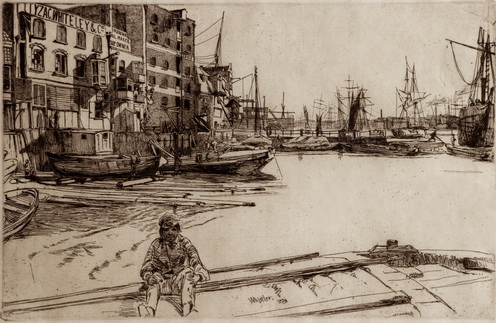Acquisition Number: 2024.9
Medium:
Etching on paper
Size:
5 ? x 8 ? in.
Date:
1859
Credit: Gift of Tom and Ginny Horner
A major figure in 19th century printmaking, Whistler created about 500 etchings over his lifetime, building a reputation as an expert etcher. A controversial figure in the Victorian art world, he was both an influential and outspoken artist, and a meticulous, hard-working craftsman. He was trained as a topographical draftsman, and as a result his etchings were drawn with precise and expressive line and printed with great technical skill. Etching offered Whistler the opportunity to sketch ideas quickly, then slowly refine and develop them through multiple states.
For his etchings, Whistler would heat a thin copper plate, cover it with an acid-resistant ground, and smoke it to produce a shiny black surface. He drew with steel etching needles, which scratched bright copper lines through the ground, then the incised lines were etched with nitric acid diluted with water, which bit down into the exposed lines. After washing the plate, Whistler checked for scratches and mistakes, which he heated, hammered out, and fixed, using 'stopping-out varnish' to protect satisfactory areas. He then inked the plate, leaving it in the etched lines and wiping it from the surface. The plate, placed on damped paper, was pulled under pressure through the printing press, with the resulting printed image appearing in reverse as fine dark lines. Since Whistler usually drew on site outdoors, his views are reversed, and he had to write his signature back to front on the plate for it to be readable. When enough impressions had been pulled from a plate, it was canceled, though in a few cases the plate was later restored and reprinted by other printers.
Whistler soon moved beyond the technical training he received, realizing that irregular patches and areas of small flecks caused by accidents in biting his plates created tonal variations that added texture and variety to his etchings. He also learned that careful wiping or manipulation of ink could enhance etched lines and the open spaces around them. Whistler experimented with formal arrangements inspired by Japanese woodblock prints. Imitating Hokusai and Hiroshige, he established distinct vertical and horizontal formats, defined space in startling new ways, and cropped forms with margins.
In 1859, seeking new inspiration and broader support, Whistler went to London and found lodgings in a wharf district below Tower Bridge. Commercial activity along the Thames, whose banks were densely lined with warehouses and wharves, inspired many of his etchings, a selection of which were published in 1871 and titled "A Series of Sixteen Etchings of Scenes on the Thames."
"Eagle Wharf" depicted here is one of the sixteen etchings from the Thames Set and one of several etchings that Whistler made of wharves along Wapping High Street. These often include depictions of local workers or inhabitants placed prominently in the foreground. Working outdoors, Whistler drew onto copper plates, then bathed the exposed metal in acid in his room to etch printable lines. Whistler sometimes referred to "Eagle Wharf" as "Tyzack Whiteley," the name of the firm Tyzack, Whiteley, & Co. visible on a building on the left. The firm was listed in the 1859 London Directory as "patent windglass, chain cable and anchor makers" at 266-7 Wapping High Street." At 268 was William Brown, sail maker.
'A Series of Sixteen Etchings of Scenes on the Thames' was published by Frederick Standridge Ellis (1830-1901) of Ellis & Green, London, in 1871. The sixteen etchings were etched between 1859 and 1871, some printed on Japanese paper.
Several impressions of the etchings were printed and exhibited by Whistler himself in the 1860s. Some were also printed by Frederick Goulding in 1864, and published by Ellis & Green in 1871. These were followed by impressions printed for the Fine Art Society in the late 1870s, again, by Goulding.
|
